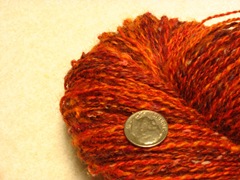Here is another picture to give you an idea of the thickness of the yarn.
As I explained earlier, the wpi of this yarn are 13-14. With that in mind, I moved on to work out what the sett would be for a twill weave.
CALCULATING MAXIMUM SETT
Turning to Volume 1 of Osterkamp's Winding a Warp & Using a Paddle, page 90 (a very coffee-stained page, I might mention in passing.........), I learn that the first thing I need to do is to calculate maximum sett. To do this, I multiply the wpi by 2/3, or, using a calculator, by the equivalent 0.67. This equals 9.38.
BALANCED WEAVE NOT POSSIBLE
Now, I cannot weave a balanced weave if I use the maximum sett. That is true of tabby, where the maximum sett would be half of the wpi. That is true of twill. The physics of the interlacing simply would not allow for it. If I were to weave a piece at maximum sett I would end up with a warp-dominant piece, not a piece with a balanced sett. Since I do want to weave a balanced weave, I need to adjust this sett of 9.38.
ALLOWING FOR USAGE
In this case, the item is for clothing, but the yarn is also more woolen than it is worsted. That means, according to Osterkamp, that I need to multiply the maximum sett by 65% to 70%. These calculations result in a sett between 6.09 and 6.56.
SETT TO USE
It looks like I am going to sett this handspun at 6 epi. That seems to me a dreadfully wide sett! So I checked Osterkamp's charts in her appendix. There I found a 3-ply wool with a wpi of 15 and a sett of 6 for the kind of item I am going to weave.
Still I am worried. Still this seems wide.
Related Post: Handspun & Computing Sett: Part I
© 2008




4 comments:
So will you... compromise by following your gut and use a slightly closer sett than the book? Sample at the wider sett first?
We shall see...... Fortunately there is lots (and i mean LOTS!) of warp to weave off on these crackle art pieces so I don't have to make a decision quickly. Also, since it is handspun, I really don't want to sample. To sample this stuff I would have to weave say 12"-15" take it off the loom and wet finish it. Simply weaving it and seeing what it looks like on the loom just would not tell enough of the story to do any good. I am not willing to "waste" any of my yarn for that.
Thanks for your comment. I'm in the exact same place with handspun and sett, right now--only in my case it's not quite so tricky, because it is only the pattern yarn. I sleyed according to my (repeated) calculations, started weaving my header and thought, "Oh no. This is going to be an absolute mess." Now I'm half way through a scarf and I'm not so worried. The interlacements are balanced, if fairly open. I don't have extra warp for regular samples, so I'm going to let my first scarf be my sample.
My feeling is that if you are working with wool, it is better to have a sett that is too open than too close. If after wet finishing, it still seems too open, the fabric can always be fulled enough to the point where you like it. And fulling can bring up a lovely halo as well. With a too close sett, you cannot do the reverse!
Post a Comment